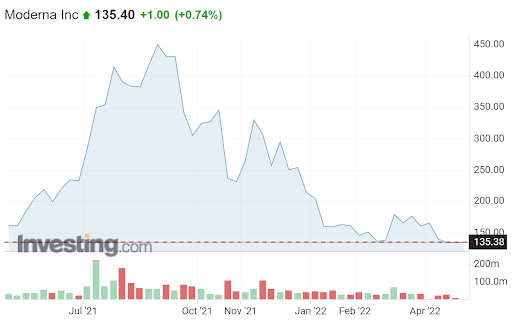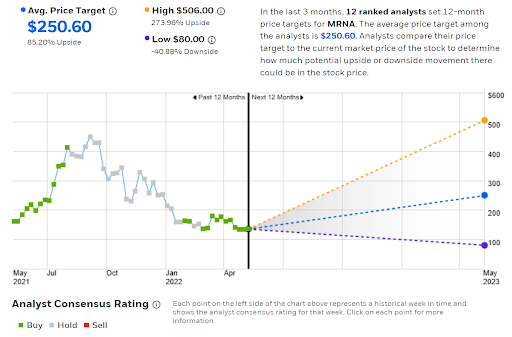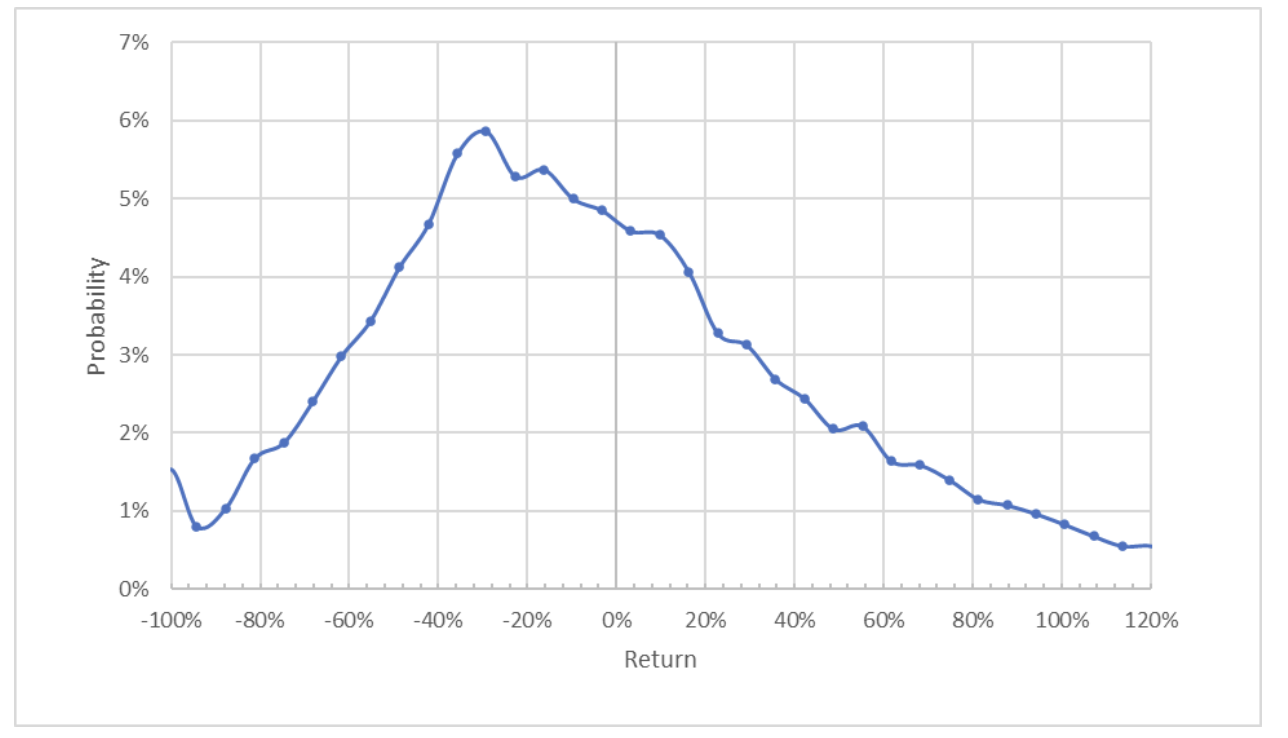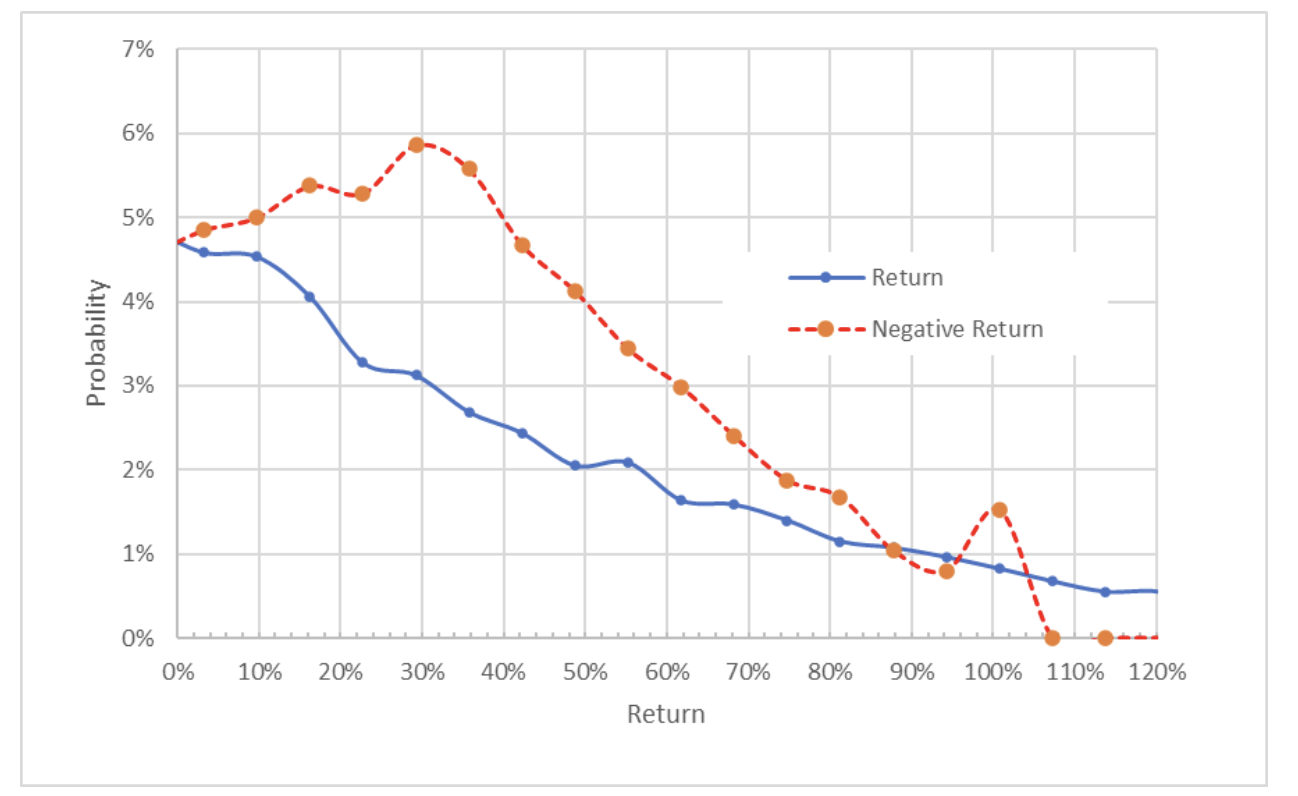Asahi shares mark weekly slide after cyberattack halts production
- Moderna reported Q1 results May 4, beating earnings expectations by more than 60%
- Shares are 72% below the 12-month high closing price hit Aug. 9
- Consensus rating is bullish, with a 12-month price target 70%-85% above current share price
- The market-implied outlook is bearish, with high volatility
- For tools, data, and content to help you make better investing decisions, try InvestingPro+.
Moderna (NASDAQ:MRNA) stock rose dramatically through the pandemic, thanks to the rapid development, testing and employment of its COVID vaccine. It shot up from $158.55 on May 10, 2021, to close at an all-time high of $484.87 on Aug. 9, 2021. Today, the shares are slightly below their value from 12 months ago and are 72% below the 12-month high close from August.

(Source: Investing.com)
The company’s earnings have increased enormously from sales of its COVID vaccine. Quarterly earnings before the pandemic were around -$0.40 per share. Quarterly EPS leapt to $2.84 for Q1 of 2021 and reached $11.30 for Q4 of 2021. The obvious question is how rapidly will the company be able to bring new products to market as the demand for COVID vaccines declines. The future earnings from the COVID vaccine are also hard to predict as variants emerge. There is also a question of how frequently people will need boosters.

(Source: E-Trade)
The prevailing view is that messenger-RNA vaccines, also known as mRNA vaccines, have enormous potential. And the COVID vaccines developed by Moderna and Pfizer (NYSE:PFE) were the first approved uses in humans. MRNA is planning to start Phase 3 trials of a flu vaccine in Q2 of 2022, along with Phase 3 trials on a vaccine for respiratory syncytial virus, known as RSV, which started in February. The company is also conducting research on dozens of additional applications of mRNA.
From an investment standpoint, the challenge is in coming up with meaningful estimates of future earnings relative to the risks. The development speed and subsequent success of the COVID vaccine is unprecedented, a combination of scientific breakthroughs with a public health emergency. Projecting forward is very difficult. I have no expertise in biotechnology or pharmaceuticals. As such, I rely on the expertise of others in estimating MRNA’s prospects. Specifically, I look at two forms of consensus outlooks. The first is the well-known Wall Street consensus rating and price target. The second is the market-implied outlook, which represents the consensus view from the options market.
For readers who are unfamiliar with the market-implied outlook, a brief explanation is needed. The price of an option on a stock reflects the market’s estimate of the probability that the stock price will rise above (call option) or fall below (put option) a specific level (the option strike price) between now and when the option expires. By analyzing the prices of call and put options at a range of strike prices, all with the same expiration date, it is possible to calculate a probable price forecast that reconciles the options prices. This is the market-implied outlook.
I wrote about MRNA on April 5, 2021, and on Feb. 15, 2022. In April 2021, when MRNA was trading at about $132, the Wall Street consensus rating was bullish, with a consensus 12-month price target that was about 25% above the share price at that time. By contrast, the market-implied outlook was significantly bearish, with expected volatility of 63% (annualized). Considering the bullish Wall Street consensus and the bearish market-implied outlook, I compromised on a neutral rating. The shares subsequently shot up to almost $485 by mid-August, before declining down to the current level of about $135.
When I analyzed MRNA on Feb. 15, prior to the release of Q4 2021 results and with the shares trading at around $133, the Wall Street consensus rating was neutral to bullish and the consensus 12-month price target was 80%-90% above the share price. The market-implied outlook continued to be substantially bearish, however, so I maintained my neutral rating.
Since my February post, MRNA has reported earnings for Q4 of 2021 and Q1 of 2022. Earnings came in at record highs for both quarters, beating expectations by more than 60% for Q1. In light of the recent earnings release, I am revisiting my rating on MRNA. I have calculated the market-implied outlook through the end of 2022 for comparison with the Wall Street consensus outlook, as in my previous analyses.
Wall Street Consensus Outlook For MRNA
E-Trade calculates the Wall Street consensus outlook for MRNA by combining the ratings and price targets from 12 ranked analysts who have published their views within the past three months. The consensus rating is bullish and the consensus 12-month price target is 85% above the current share price.
A significant red flag is the high dispersion among the individual price targets. The highest 12-month price target is more than five times the lowest. Research has shown that the consensus price target is actually negatively correlated, with subsequent returns when the dispersion is high. In other words, the high consensus price target combined with the high dispersion is a bearish indicator.
The $80 price target (from SVB Securities), the lowest in the group, is an outlier, while the next three lowest price targets are $155 (from Deutsche Bank), $170 (from Jefferies) and $180 (from Bank of America Securities). The highest price target, $506 (from Brookline Capital Markets), is well above the second highest, $397 (from Goldman Sachs), but is not obviously an outlier. As a rule of thumb, I substantially discount the usefulness of the consensus price target when the highest individual target is more than twice the lowest. Even throwing out the highest and the lowest as possible outliers, the spread between the second highest and second lowest is a difference of 2.5X ($155 vs. $397).

(Source: E-Trade)
Investing.com calculates the Wall Street consensus outlook using ratings and price targets from 19 analysts. The results are generally consistent with those from E-Trade, with a bullish consensus rating and high dispersion among the individual price targets. The consensus 12-month price target is 68% above the current share price (as compared with 85% for E-Trade’s consensus), but this difference is of relatively little significance given the very large spread among the individual analyst price targets.

(Source: Investing.com)
The Wall Street consensus outlook supports the conclusion that there is very little that is agreed upon in the outlook for MRNA. The consensus price target is simply not very meaningful, except perhaps as a bearish indicator, given the enormous spread in the individual price targets. This is a persistent feature of the analyst price targets for MRNA.
Market-Implied Outlook For MRNA
I have calculated the market-implied outlook for MRNA for the 8.4-month period from now until Jan. 20, 2023, using the prices of options that expire on this date. I selected this specific option expiration date to provide a view through the end of the year and because the January options tend to be among the most actively traded. In addition, I analyzed the January 2023 options in my last analysis, in February, so it is of interest to look at changes in the outlook to this date.
The standard presentation of the market-implied outlook is a probability distribution of price return, with probability on the vertical axis and return on the horizontal.

(Source: Author’s calculations; options quotes from E-Trade)
As in my previous analysis, the outlook to January 2023 is significantly tilted to favor negative returns. The maximum probability corresponds to a price return of -29% over this 8.4-month period. This is a bearish outlook. The expected volatility calculated from this distribution is 72% (annualized), modestly higher than in February. This change is probably due to rising market volatility.
To make it easier to directly compare the probabilities of positive and negative returns, I rotate the negative return side of the distribution about the vertical axis (see chart below).

(Source: Author’s calculations; options quotes from E-Trade)
The probabilities of negative returns are markedly higher than the probabilities of positive returns of the same size, across a wide range of the most-probable outcomes (the dashed red line is well above the solid blue line across the left two-thirds of the chart above). The chart above is qualitatively similar to the outlook using the January 2023 options from February.
The market-implied outlook to early 2023 is bearish, with high volatility. It is not substantially different from the outlook to early 2023 that I calculated prior to the last two quarterly earnings reports.
Summary
Moderna has demonstrated the potential of messenger-RNA therapeutics in grand fashion, but the company has only one product on the market, the COVID vaccine. While the company has a substantial pipeline and there is reason for significant enthusiasm for the future, estimating the company’s trajectory over the next several years is fraught with uncertainty. While it is common for pharmaceutical companies to face make-or-break drug trials, MRNA has yet to demonstrate the ability to bring a diverse portfolio of products to market. The Wall Street consensus outlook is bullish, but there is a wide dispersion in the individual analyst outlooks lending little meaning to the consensus. The high implied return from the consensus price target, along with the large spread in the individual price targets, actually tends to be a bearish indicator. The market-implied outlook to early 2023 continues to be bearish, with high volatility. Even with exciting prospects for messenger-RNA therapeutics and the impressive track record with the COVID vaccine, as reflected in recent earnings, the outlook for the company is incredibly hard to predict. I am maintaining a neutral overall rating on MRNA.
Interested in finding your next great idea? InvestingPro+ gives you the chance to screen through 135K+ stocks to find the fastest growing or most undervalued stocks in the world, with professional data, tools, and insights. Learn More »
